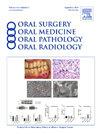Clinicopathological and immunohistochemical aspects of conventional and unicystic canalicular adenoma: a case series
IF 2
3区 医学
Q2 DENTISTRY, ORAL SURGERY & MEDICINE
Oral Surgery Oral Medicine Oral Pathology Oral Radiology
Pub Date : 2024-09-03
DOI:10.1016/j.oooo.2024.08.022
引用次数: 0
Abstract
Objective
To describe a well-documented series of 10 new cases of conventional and unicystic canalicular adenoma (CAD).
Study design
This was a retrospective study in which the original hematoxylin and eosin and immunohistochemical slides of all cases of CAD diagnosed between 2014 and 2024 were re-evaluated. Clinical data regarding age, gender, clinical presentation, evolution time, and related symptoms were retrieved from the patients’ medical records.
Results
Ten CADs were identified. Most patients were female (n = 6), with a mean age of 61.2 years. Most tumors presented as a solitary asymptomatic nodule, particularly on the upper lip (n = 7), and two patients reported slight pain or sensitivity. All tumors were well-delimited with a connective tissue capsule. A bosselated or lobulated appearance and cystic formation were observed in all cases. Other features were also observed, such as solid areas, clear cells, beading, morules, and pseudostratification. Eight cases were classified as conventional and two as unicystic. All cases were positive for CK7, S100 protein, and SOX10, while negative for p40 and p63.
Conclusions
This paper described 10 additional cases of CAD, with classic and uncommon microscopic findings, including unicystic. We highlighted the importance of an immunohistochemical panel in differentiating CAD from other salivary gland tumors.
传统管状腺瘤和单囊管状腺瘤的临床病理和免疫组化:一个病例系列
描述一系列证据确凿的 10 例传统和单囊管状腺瘤(CAD)新病例。
本文章由计算机程序翻译,如有差异,请以英文原文为准。
求助全文
约1分钟内获得全文
求助全文
来源期刊

Oral Surgery Oral Medicine Oral Pathology Oral Radiology
DENTISTRY, ORAL SURGERY & MEDICINE-
CiteScore
3.80
自引率
6.90%
发文量
1217
审稿时长
2-4 weeks
期刊介绍:
Oral Surgery, Oral Medicine, Oral Pathology and Oral Radiology is required reading for anyone in the fields of oral surgery, oral medicine, oral pathology, oral radiology or advanced general practice dentistry. It is the only major dental journal that provides a practical and complete overview of the medical and surgical techniques of dental practice in four areas. Topics covered include such current issues as dental implants, treatment of HIV-infected patients, and evaluation and treatment of TMJ disorders. The official publication for nine societies, the Journal is recommended for initial purchase in the Brandon Hill study, Selected List of Books and Journals for the Small Medical Library.
 求助内容:
求助内容: 应助结果提醒方式:
应助结果提醒方式:


